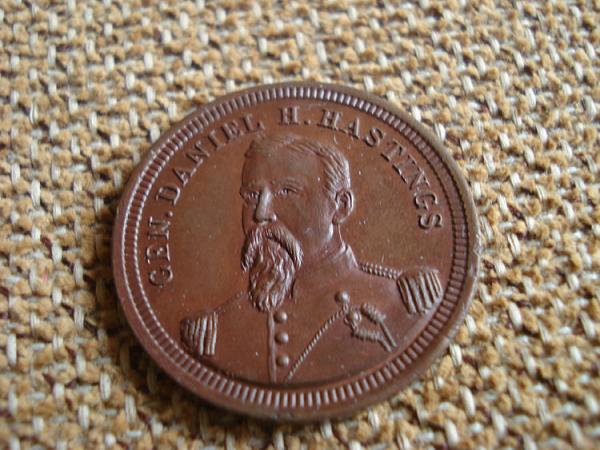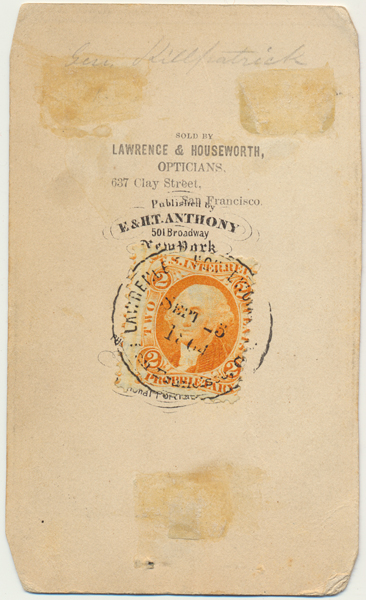NOTE : GREAT CONTRAST WITH VERTICAL CREASE
Kilpatrick, Judson, major-general, was born in
Deckertown, N. J. Jan. 14, 1836, and was graduated at West
Point in 1861. He was appointed captain of volunteers, May 9,
promoted 1st lieutenant of artillery, May 14, and in the
action at Big Bethel on June 1O received a severe wound which
disabled him for several months. Upon his return to the army
he was detailed on recruiting duty, organized a regiment of
New York volunteer cavalry, of which he became lieutenant-
colonel in September, and in Jan., 1862, went to Kansas to
accompany Gen. Lane in the expedition to Texas as chief of
artillery. Upon the abandonment of this project, Kilpatrick
rejoined his regiment in Virginia, where he participated in
the skirmishes near Falmouth in April, the movement to
Thoroughfare gap in May; raids on the Virginia Central
railroad in July, and skirmishes at Carmel Church on July 23.
He was also present in various other skirmishes and at the
second battle of Bull Run, and in the expedition to Leesburg,
Sept. 19, commanded a cavalry brigade. After several months,
absence on recruiting service, during which time he became
colonel of the 2nd N. Y. Cavalry, he returned to the field
and commanded a brigade of cavalry in the Rappahannock
campaign, engaging in Stoneman's raid toward Richmond, April-
May, 1863, and in the battle at Beverly ford on June 9. He
was commissioned brigadier-general of volunteers, June 13,
1863, and commanded a cavalry brigade and division in the Army
of the Potomac, participating in the actions at Aldie, where
he commanded and won the brevet of major, Middlebury, and
Upperville and in the battles of Hanover, Hunterstown and
Gettysburg, and in the pursuit of the enemy after the last
named battle, being engaged in constant fighting at
Smithsburg, Hagerstown, Boonsboro and Falling Waters He
commanded a cavalry division in the operations in central
Virginia from August until Nov., 1863, took part in the
expedition to destroy the Confederate gunboats, "Satellite"
and "Reliance," in Rappahannock river the action at Culpeper
on Sept. 13, and the subsequent skirmish at Somerville ford,
the fights at James City and Brandy Station, and in the
movement to Centerville and the action at Gainesville, Oct.19.
He participated in the action at Ashland, Va., May 1, 1864, in
many skirmishes, and took part in the invasion of Georgia as
commander of a cavalry division of the Army of the Cumberland,
being engaged in the action at Ringgold, April 29, the
operations about Dalton, May 7-13, and in the battle of Resaca
where he was severely wounded. Having previously been
brevetted lieutenant-colonel for gallantry at Gettysburg, he
was given the brevet rank of colonel for gallant and
meritorious conduct at Resaca, and upon his return to the
service in the latter part of July, 1864, guarded Sherman's
communications, and raided and took part in several heavy
skirmishes with the Confederates. He participated in numerous
skirmishes during the march to the sea and commanded a cavalry
division during the invasion of the Carolinas, where he
engaged in many actions and skirmishes. From April to June,
1865, he commanded a division of the cavalry corps of the
Military Division of the Mississippi. He was brevetted major-
general of volunteers Jan. 15,1865, and brigadier-general and
major-general U. S. A. on March 13 of that year, resigning his
volunteer commission Jan. 1, 1866, and his commission in the
regular army in 1867. Gen. Kilpatrick envoy extraordinary and
minister plenipotentiary to Chili, 1865-68, an unsuccessful
candidate for Congress in 1880, and was appointed minister to
Chili again in 1881. He died in Santiago, Chili, Dec. 4,
1881, and his remains were afterward brought to the United
States and buried at West Point N. Y.



